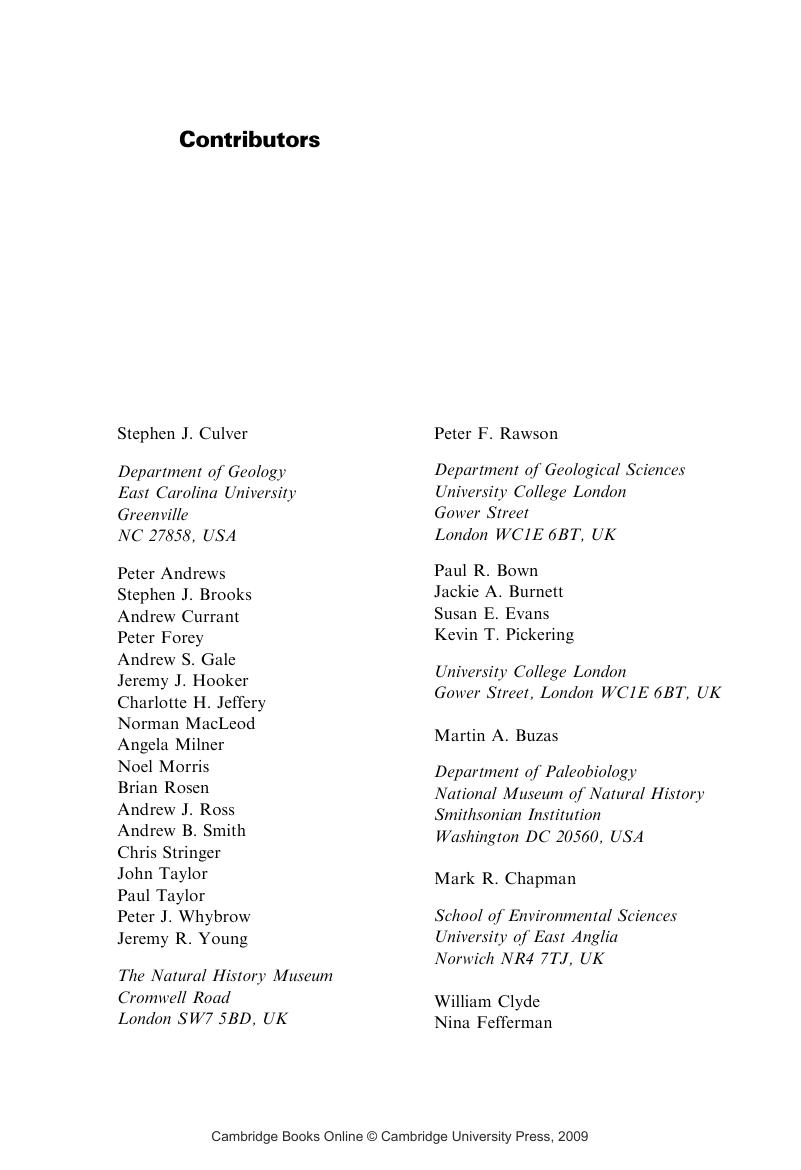Book contents
- Frontmatter
- Contents
- List of contributors
- Preface
- 1 Introduction
- 2 The Cretaceous world
- 3 The Cenozoic world
- 4 Calcareous nannoplankton and global climate change
- 5 Phenotypic response of foraminifera to episodes of global environmental change
- 6 The response of planktonic foraminifera to the Late Pliocene intensification of Northern Hemisphere glaciation
- 7 The response of Cretaceous cephalopods to global change
- 8 Global change and the fossil fish record: the relevance of systematics
- 9 Response of shallow water foraminiferal palaeocommunities to global and regional environmental change
- 10 Intrinsic and extrinsic controls on the diversification of the Bivalvia
- 11 Global events and biotic interaction as controls on the evolution of gastropods
- 12 Algal symbiosis, and the collapse and recovery of reef communities: Lazarus corals across the K–T boundary
- 13 Changes in the diversity, taxic composition and life-history patterns of echinoids over the past 145 million years
- 14 Origin of the modern bryozoan fauna
- 15 Angiosperm diversification and Cretaceous environmental change
- 16 Cenozoic evolution of modern plant communities and vegetation
- 17 Leaf physiognomy and climate change
- 18 Biotic response to Late Quaternary global change – the pollen record: a case study from the Upper Thames Valley, England
- 19 The Cretaceous and Cenozoic record of insects (Hexapoda) with regard to global change
- 20 The palaeoclimatological significance of Late Cenozoic Coleoptera: familiar species in very unfamiliar circumstances
- 21 Amphibians, reptiles and birds: a biogeographical review
- 22 Paleogene mammals: crises and ecological change
- 23 Response of Old World terrestrial vertebrate biotas to Neogene climate change
- 24 Mammalian response to global change in the later Quaternary of the British Isles
- 25 Human evolution: how an African primate became global
- 26 The biotic response to global change: a summary
- References
- Index
List of contributors
Published online by Cambridge University Press: 14 August 2009
- Frontmatter
- Contents
- List of contributors
- Preface
- 1 Introduction
- 2 The Cretaceous world
- 3 The Cenozoic world
- 4 Calcareous nannoplankton and global climate change
- 5 Phenotypic response of foraminifera to episodes of global environmental change
- 6 The response of planktonic foraminifera to the Late Pliocene intensification of Northern Hemisphere glaciation
- 7 The response of Cretaceous cephalopods to global change
- 8 Global change and the fossil fish record: the relevance of systematics
- 9 Response of shallow water foraminiferal palaeocommunities to global and regional environmental change
- 10 Intrinsic and extrinsic controls on the diversification of the Bivalvia
- 11 Global events and biotic interaction as controls on the evolution of gastropods
- 12 Algal symbiosis, and the collapse and recovery of reef communities: Lazarus corals across the K–T boundary
- 13 Changes in the diversity, taxic composition and life-history patterns of echinoids over the past 145 million years
- 14 Origin of the modern bryozoan fauna
- 15 Angiosperm diversification and Cretaceous environmental change
- 16 Cenozoic evolution of modern plant communities and vegetation
- 17 Leaf physiognomy and climate change
- 18 Biotic response to Late Quaternary global change – the pollen record: a case study from the Upper Thames Valley, England
- 19 The Cretaceous and Cenozoic record of insects (Hexapoda) with regard to global change
- 20 The palaeoclimatological significance of Late Cenozoic Coleoptera: familiar species in very unfamiliar circumstances
- 21 Amphibians, reptiles and birds: a biogeographical review
- 22 Paleogene mammals: crises and ecological change
- 23 Response of Old World terrestrial vertebrate biotas to Neogene climate change
- 24 Mammalian response to global change in the later Quaternary of the British Isles
- 25 Human evolution: how an African primate became global
- 26 The biotic response to global change: a summary
- References
- Index
Summary

- Type
- Chapter
- Information
- Biotic Response to Global ChangeThe Last 145 Million Years, pp. xi - xiiPublisher: Cambridge University PressPrint publication year: 2000

